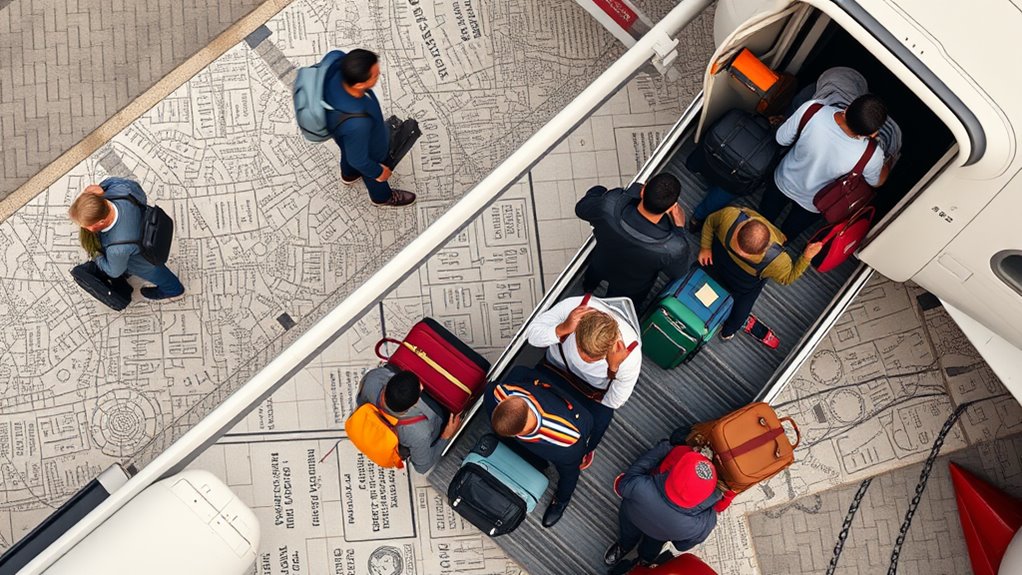You can travel without a passport if you're a U.S. citizen visiting Canada and Mexico. Just bring a birth certificate along with a government-issued photo ID. If you prefer cruising, closed-loop cruises let you explore destinations like Mexico and the Bahamas without needing a passport—only proof of citizenship is required. Additionally, for trips to U.S. territories such as Puerto Rico, a valid ID is all you need. Each option allows you to visit places easily without the hassle of a passport. There's plenty more to explore about travel options beyond passports.
Essential Insights
- U.S. citizens can travel to certain countries without a passport, using alternative documents like a birth certificate and photo ID for specific crossings.
- Closed-loop cruise passengers can travel to destinations like Mexico and the Bahamas without a passport, requiring only a government-issued photo ID and proof of citizenship.
- Travel to U.S. territories such as Puerto Rico and Guam does not require a passport; a valid ID suffices for entry.
- Some countries allow visa-free travel for American passport holders, enabling entry without a visa for specific durations, though a passport is generally needed for international travel.
- Digital nomad visa holders may live in specific countries while working remotely, but a passport is required for application and entry.
Travel by Road to Canada and Mexico

Traveling by road to Canada and Mexico can be a straightforward process, but you'll need to have the right documentation ready. Before you hit the road, gather your road trip essentials: proof of citizenship, a valid driver's license, vehicle registration, and insurance that covers driving in Canada.
If you're heading to Mexico, don't forget to secure your Mexico tourist card, which costs about $29 USD, and a temporary vehicle permit if you plan to travel beyond 16 miles from the border.
For border crossing tips, remember that obtaining your temporary vehicle permit can be done at a Banjercito outpost or online; just verify you have your vehicle registration with you. You'll need to pay a fee of approximately $59 USD to get this permit.
When entering Mexico, immigration officials will issue your tourist card, so make sure to keep it safe and return it upon exiting to avoid fines.
In Canada, there's no separate tourist card required, but compliance with local traffic laws is crucial. It's wise to familiarize yourself with Canadian driving regulations and local conditions since they can differ greatly from those in the U.S. Additionally, ensure you have valid travel and identification documents as they are essential for a smooth crossing into Canada.
Keep all necessary documents accessible during your trip to guarantee a smooth border crossing experience. Finally, consider using the CBP Border Wait Time app to check for any delays at the ports of entry, helping you plan your journey more efficiently.
WHTI-Compliant Documents Explained

When crossing borders by land or sea, understanding WHTI-compliant documents is key to a smooth experience. The Western Hemisphere Travel Initiative (WHTI) establishes specific requirements for travelers entering the U.S. These documents serve as proof of identity and citizenship, allowing you to travel without a passport in certain situations. Having a valid passport increases travel opportunities and access to various destinations.
Here's a quick overview of the accepted travel document types under WHTI requirements:
| Document Type | Description |
|---|---|
| U.S. Passport Card | A wallet-sized card that proves U.S. citizenship. |
| Trusted Traveler Program Cards | Includes NEXUS, SENTRI, and FAST for expedited travel. |
| Enhanced Driver's License | Available for Canadian citizens with added security features. |
| Birth Certificate + Photo ID | For U.S. citizens under specific conditions. |
| Permanent Resident Card | Required for lawful permanent residents. |
You can use these documents for land and sea travel to destinations like Canada and Mexico, but not for air travel. U.S. citizens can utilize passport cards or trusted traveler cards, while Canadian citizens have the option of an Enhanced Driver's License or trusted traveler cards. Lawful permanent residents must present their Permanent Resident Card. Remember, children under 16 may only need proof of citizenship, depending on where you're headed.
Air Travel Passport Requirements

For international air travel, you'll always need a valid passport. This essential document must be valid for at least six months beyond your arrival date in some countries, and you should also check the specific requirements regarding blank pages for your destination.
While booking an international flight, you typically don't need your passport upfront, but some airlines might ask for your passport details during the process. Remember, you must present your passport when it's time to travel.
When it comes to domestic flights within the U.S., you won't need a passport. Instead, you can use state-issued driver's licenses or ID cards. As of May 7, 2025, you'll need a REAL ID-compliant driver's license or ID card to board domestic flights, so be sure to check for the star in the top right corner of your ID. A passport is mandatory for international travel across borders, so ensure you have it ready for your trips.
Emerging travel technology is changing the landscape of air travel. Biometric options for identity verification are becoming popular for their speed and convenience.
While these passport alternatives could streamline the travel process, legislation is still a major hurdle in fully implementing passport-free travel through biometrics. As you plan your travels, stay informed about the latest requirements and technologies to guarantee a smooth journey.
Whether you're flying domestically or internationally, understanding these passport requirements will help you navigate your travel plans with ease.
Sea Travel Options Without Passport

While air travel typically requires a passport for international journeys, sea travel offers some flexibility, particularly for closed-loop cruises that start and end at the same U.S. port.
These cruise options let you explore destinations like Bermuda, Mexico, and the Bahamas without needing a passport. Instead, you only need a government-issued photo ID and proof of citizenship, such as a driver's license and a certified copy of your birth certificate.
If you're contemplating a Western Caribbean cruise, ports like Miami and Galveston serve as popular departure points. You can visit places like Puerto Rico and the U.S. Virgin Islands without a passport, just armed with your ID and proof of citizenship. Numerous U.S. cruise ports offer easy access to various Caribbean islands.
Major cruise lines like Royal Caribbean, Carnival, and Celebrity Cruises offer these exciting itineraries.
Even if you're interested in cruising to Alaska, you can enjoy the journey without a passport, as long as you have valid identification and proof of citizenship. Many cruises include stops in Canadian ports, so make sure to check the cruise line's requirements.
While you won't need a passport, it's wise to think about travel insurance for emergencies that might require you to stay abroad.
Always verify the specific travel documentation needed by your cruise line, as policies can vary. This flexibility allows for spontaneous travel plans, making your next adventure that much easier to initiate!
Domestic Travel Within U.S. Territories

Traveling between the U.S. and its territories offers a streamlined experience, where you can enjoy beautiful destinations without the hassle of a passport. You can easily hop from one stunning island to another, exploring the vibrant cultures and unique landscapes of places like Puerto Rico, Guam, and the U.S. Virgin Islands. All you need is a valid form of ID, making this an accessible option for U.S. citizens looking to broaden their horizons. Additionally, U.S. citizens do not need a passport for travel to most U.S. territories, which further simplifies your journey.
When you fly to these territories, you won't face the same border checks you'd with international travel. Major airlines like American Airlines, Delta, and United operate domestic flights from various cities, so booking your trip is a breeze. Whether you're departing from Miami, New York, or Washington DC, you can quickly reach your tropical getaway without worrying about complex travel requirements.
Once you arrive, immerse yourself in the local culture by sampling traditional cuisines, participating in local festivals, or visiting historical landmarks. These territories are rich in cultural experiences that reflect a blend of influences, making every destination a unique adventure.
Don't forget about American Samoa, where you'll need a certified U.S. birth certificate for entry, but the process remains simple.
U.S. Territories You Can Visit

Exploring U.S. territories is an exciting way to experience diverse cultures and stunning landscapes without the need for a passport. As a U.S. citizen, you can easily travel to places like Puerto Rico, the U.S. Virgin Islands, Guam, the Northern Mariana Islands, and American Samoa. Each location offers unique U.S. Territory attractions that cater to various interests.
In Puerto Rico, immerse yourself in rich cultural heritage, historical sites, and breathtaking natural wonders. The U.S. Virgin Islands boast pristine beaches and vibrant water sports, making it a paradise for adventure seekers. Meanwhile, Guam features historic sites and cultural festivals, enhancing your travel experience. The Northern Mariana Islands are perfect for diving enthusiasts, while American Samoa invites you to explore its national parks and traditional Samoan culture. Additionally, many countries allow entry without a visa for U.S. citizens, enhancing travel convenience and increasing accessibility for exploring these territories.
Travel requirements are straightforward: you won't need a passport, but carrying a valid ID is crucial. You can seamlessly travel between U.S. territories and the mainland without any hassle. Just make sure you comply with Homeland Security regulations for a smooth journey.
With tourism being a significant contributor to the economies of these territories, your visit can support local communities while providing you with unforgettable experiences. So pack your bags and get ready to enjoy the incredible U.S. territories waiting for you!
Digital Nomad Visa Essentials

For many aspiring digital nomads, understanding the essentials of a digital nomad visa can open up a world of opportunities. This visa allows you to embrace the digital nomad lifestyle while living in a foreign country.
To get started, make certain you meet the eligibility criteria. You'll need to be over 18, have a specific monthly income, and prove that your job is remote. Some countries might also require a clean criminal record and health insurance for your stay.
The application process typically involves filling out a visa application form, which you can do online or in person. Make an appointment at the nearest embassy or consulate to submit your application.
Be prepared with required documents such as your passport, identity pictures, proof of income, and evidence of remote work. If needed, you may also attend a visa interview. Don't forget to budget for the visa application fee, which varies by country.
When applying, keep these visa application tips in mind: verify your passport is valid for at least six months, use a plain white background for your identity pictures, and maintain clear financial records.
The benefits of obtaining a digital nomad visa can be substantial. Not only do you gain easy residence, but you may also enjoy local healthcare and education for your family.
Plus, some countries offer tax optimization benefits, allowing you to focus on your work while exploring new cultures.
Countries Offering Digital Nomad Visas

Many countries now recognize the growing trend of remote work and have introduced digital nomad visas to attract location-independent professionals. This creates exciting digital nomad opportunities for you to explore new cultures while working from picturesque locations.
Countries like Portugal, Estonia, and Thailand offer these visas, usually valid for up to one year, so you can immerse yourself in your chosen destination without the hassle of frequent visa renewals.
Applying for a digital nomad visa is often straightforward. Most countries provide online applications, and many process them within a month. However, you'll need to complete the application form accurately and submit it with the required documents, including proof of remote work and your income, which typically needs to meet a minimum threshold—around €3,500 in some cases.
While 39% of these destinations exempt you from tax payments, it's wise to consult a tax professional to navigate any complexities.
High-speed internet and robust digital infrastructure are critical to enjoying the remote work benefits that these countries offer. You'll find plenty of co-working spaces and comfortable accommodations that cater to digital nomads like yourself.
Plus, your presence can positively impact local economies through increased spending, enhancing the community's vibrancy.
Visa-Free Travel Overview

Understanding visa-free travel opens up a world of possibilities for you as a traveler. With the right passport, you can explore various countries without the hassle of obtaining a visa in advance. This includes visa-free access, visa on arrival, and eVisas, which simplify your journey. The visa-free advantages are clear: reduced costs, saved time, and enhanced spontaneity in your travel plans.
Global trends show a significant shift in visa policies, as many countries are relaxing restrictions to attract more tourists. In 2023, an estimated 1.3 billion international tourists highlight how crucial these policies are to the global economy. Countries are increasingly recognizing that easing visa requirements can lead to substantial increases in tourist arrivals, stimulating local economies and creating jobs.
While the benefits are evident, it's important to reflect on the security and policy implications. Visa-free travel still requires some level of security control, and nations must balance attracting visitors with maintaining safety.
Additionally, the ongoing evolution of visa policies reflects a growing awareness of the need for reciprocity, as critics point out that these advantages often favor wealthier nations.
As you navigate your travel options, keep an eye on these global trends. The landscape of international travel is continually changing, and understanding the nuances of visa-free travel can enhance your adventure.
Countries for Visa-Free Travel

While exploring your travel options, you might be surprised to discover the vast number of countries that offer visa-free access. With an American passport, you can enjoy visa-free travel to 117 countries, providing numerous travel opportunities. Countries like Germany lead the way, allowing access to over 177 destinations without the hassle of a visa.
If you're considering traveling to Asia, countries such as Japan and Brunei welcome you with visa-free entry for various lengths of stay. In North America, you can easily travel to Belize, Guatemala, and Jamaica, among others, all of which offer visa-free access for varying durations.
South America also holds great promise with countries like Brazil and Peru, allowing you to stay visa-free for up to 90 days. Europe's visa-free countries, including France, Italy, and the UK, provide even more travel opportunities without the need for a visa.
Meanwhile, regions in Africa, like Seychelles and Tunisia, also offer visa-free access, making it easier to explore the continent. Just keep in mind that some countries may request proof of onward travel or sufficient funds during your visit.
While many destinations are open and welcoming, a few, like Bhutan and Nauru, impose strict and costly entry requirements. So, as you plan your next adventure, consider these visa-free countries and the incredible travel opportunities they present!
Top Remote Work Destinations

Once you've explored the exciting landscape of visa-free travel, it's time to contemplate where you might want to work remotely. The world is full of fantastic destinations that cater to the digital nomad lifestyle, offering a mix of vibrant communities, reliable internet, and a supportive atmosphere for remote work.
In Europe, Denmark stands out with its social inclusiveness and exceptional healthcare, making it ideal for remote work benefits. The Netherlands and Germany also shine due to their strong digital infrastructure and legal protections for cyber safety.
If you're looking for a budget-friendly option, Portugal, especially Madeira, provides an excellent quality of life at a low cost.
Heading to the Americas, Costa Rica's pristine beaches and community vibe are perfect for those who crave a unique work environment. Canada's Toronto boasts a high quality of life and safety, while Colombia's Medellín merges tech-forward amenities with a rich expat community.
Mexico's Oaxaca offers cultural experiences alongside a supportive network for digital nomads.
In Asia, Japan's Tokyo dazzles with safety and high internet speeds, while Taiwan welcomes you with its Gold Card for digital nomads.
Thailand's Bangkok is known for its lively expat scene, making it an appealing choice.
Don't overlook destinations like Estonia, New Zealand, and Iceland, each offering a blend of modern amenities and natural beauty, ensuring remote work benefits that align with your digital nomad lifestyle.
Factors Influencing Remote Work Locations

Several key factors influence your choice of remote work locations, shaping the overall experience and feasibility of working from different areas. Understanding these factors can help you make informed decisions about where to base your work life.
- Urban infrastructure: Larger cities often provide better facilities that support remote work, including reliable internet and coworking spaces.
- Economic opportunities: Areas with strong remote job markets tend to attract highly skilled workers due to the availability of well-paying jobs that can be done from anywhere.
- Healthcare access: Having access to quality healthcare and flexible insurance options is essential for sustaining a remote work lifestyle.
Urban versus rural settings play a significant role in your decision-making. While urban areas like New York and Los Angeles offer more remote job opportunities, smaller towns might attract you with affordable housing and a closer connection to nature.
However, it's important to reflect on the urban infrastructure, as reliable internet is fundamental for remote work success.
Economic and educational factors also weigh heavily on your choices. Higher income requirements and educational opportunities can draw you to certain locations where remote jobs are more prevalent.
Additionally, tax and legal considerations shouldn't be overlooked, as they can impact your overall experience. With the right balance of these factors, you can optimize your remote work life while enjoying the flexibility of choosing where to live and work.
Financial Strategies for Travelers

Balancing work and travel requires a solid financial strategy to guarantee you can enjoy your adventures without breaking the bank. Start by creating a detailed budget that tracks your current spending habits, allowing you to identify areas where you can cut back. Allocate a portion of your income towards travel and retirement savings, adjusting as necessary.
Be sure to include all expenses in your budget—groceries, transportation, entertainment, and dining out.
When it comes to travel budgeting, planning for unplanned expenses is essential. Set aside about $149 for emergencies during your trip. Use budget breakdowns to categorize your expenses into accommodations, transportation, food, activities, and entertainment. This will help you stay on track.
For effective savings tips, flexibility is key. Adjust your vacation dates to secure better deals on airline tickets. Use flight comparison sites like Kayak or Google Flights to find the best prices. Booking your flights and hotel stays early can also lead to significant savings, especially during peak times.
Consider off-season travel for even more savings on accommodations and activities. Utilize deal-finding apps and credit card points whenever possible. Additionally, choose affordable destinations like Thailand or the Balkans to stretch your budget further.
Tips for Budget Travel

Budget travel doesn't have to mean sacrificing experiences; with the right strategies, you can explore new destinations without spending a fortune. By planning smartly and being flexible, you can uncover amazing opportunities without breaking the bank.
Here are some tips to help you make the most of your budget travels:
- Travel in the off-season to snag cheaper flights and budget accommodation.
- Use travel fare watch websites to find discounted flights and last-minute deals.
- Eat local cuisine by dining where the locals go, or even try cooking your own meals.
When it comes to transportation, ditch the taxis and rental cars. Instead, opt for public transport, which not only saves you money but also gives you a taste of local life.
If you're traveling by train, look into rail passes or book individual tickets in advance for significant savings. Packing light can also help you avoid those pesky baggage fees.
For accommodation, consider platforms like Hostel World or Couchsurfing to find budget-friendly options. Renting an apartment can be a great choice for longer stays.
Always look for discounts and deals on accommodation websites to guarantee you get the best prices.
Lastly, immerse yourself in the local culture by seeking out free or low-cost activities. Ask locals for recommendations on affordable dining and attractions, and you'll discover hidden gems that make your trip unforgettable.
Happy travels!
Frequently Asked Questions
Can I Travel Without a Passport if I'm Not a U.S. Citizen?
Imagine standing at the edge of a vast ocean, but travel restrictions hold you back like an anchor.
If you're not a U.S. citizen, you can't just slip away without a passport. Most countries require it for identity verification, and while some places might accept alternative documents, they're rare.
Always check the specific entry requirements for your destination, as they can vary widely based on your nationality and the country's rules.
What Documents Do Minors Need for Passport-Less Travel?
If you're planning minor travel, you need to be aware of specific document requirements.
A notarized letter of consent from both parents is essential, stating the trip details.
Don't forget the child's birth certificate and valid identification, like a passport if available.
Depending on the destination, you might need additional documents, such as a signed letter or custody papers.
Always check country-specific rules to guarantee a smooth journey for your child.
Are There Countries Where U.S. Citizens Need a Visa Despite Having a Passport?
Yes, there are several countries where you'll need a visa despite having a U.S. passport.
Countries like China, India, and Russia impose strict visa requirements and travel restrictions.
For instance, China requires a visa for all entries, while India offers different types based on your purpose of travel.
Always check the specific visa policies and entry rules before planning your trip to avoid any complications during your travels.
Can I Travel to Puerto Rico Without a Passport if I'm a Non-U.S. Citizen?
If you're a non-U.S. citizen, you can't travel to Puerto Rico without a valid passport.
You'll also need to follow visa requirements just like visiting the mainland U.S. If you're from a Visa Waiver Program country, get an approved ESTA and a valid e-passport.
Make certain to have any additional documents ready, like your travel itinerary and proof of accommodation.
Planning ahead guarantees a smooth Puerto Rico travel experience for you.
What Are the Consequences of Traveling Without a Passport?
Traveling without a passport can lead to serious legal implications.
You might face travel restrictions, including being denied entry into countries or getting deported back to where you came from.
Administrative sanctions like passport revocation could also occur.
If you attempt to cross borders without the necessary documents, you risk arrest or fines.
